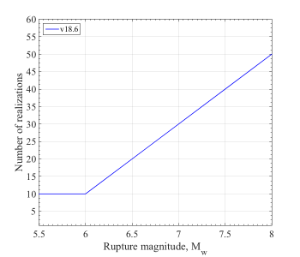At this step, we calculate how many simulation jobs are needed for each fault given a model based on rupture magnitude (such as the one below):
Note that the median rupture magnitude used in this process is based on Leonard 2010 magnitude scaling relationship which differs from the values prescribed in Stirling et al 2012 national hazard model. This file contains the fault name, median rupture magnitude based on Leonard 2010, length, width, and rake of all the finite faults in the national hazard model: Fault_LeonardMag_Length_Width_Rake.txt
A simple code as the one written in matlab here (run_C18p6_NumSim.m) can be used to determine the number of simulations for the considered faults. This code takes three inputs:
1- A model (as shown in the above figure)
2- A file containing the fault name, median rupture magnitude based on Leonard 2010, length, width, and rake of all the finite faults in the national hazard model: Fault_LeonardMag_Length_Width_Rake.txt
Note: If the magnitude and geometry of faults are kept as those prescribed in NHM, the file will still be relevant and does not need to be changed (considering the fact that Mw is calcualted based on the median of the Leonard model). If Mw uncertainty is added, then this file should be changed.
3- A file containing the list of the faults that are considered in for a a given Cybershake run (such as CS_list_v18p6.txt ) which is obtained in Step one Step 1: Determine the list of faults considered
The output of this code is a file (such as fault_selection_c18p6_for_SRF.txt)
to do: create a paython version of this code and integrate it into the workflow.
